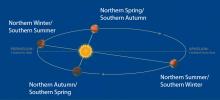Listen to today's episode of StarDate on the web the same day it airs in high-quality streaming audio without any extra ads or announcements. Choose a $8 one-month pass, or listen every day for a year for just $30.
You are here
Moon, Venus, El Nath
As we move toward summer here in the northern hemisphere, we can look forward to longer, warmer days. Most of the other planets go through cycles of seasons as well. But not Venus. There’s nothing to cause the seasons to change. So the climate stays the same all year across the entire planet.
Venus is the brilliant “evening star.” It’s below the crescent Moon this evening. The star El Nath is closer above the Moon, with Aldebaran, the bright orange eye of the bull, well to the lower left of Venus.
The seasons on Earth are caused by our planet’s tilt on its axis. For part of the year, the north pole tips toward the Sun, bringing longer, warmer days to the northern hemisphere. And for the rest of the year, the south pole tips sunward, bringing light and heat to the southern hemisphere.
Venus is flipped upside down compared to Earth and most other planets. But its tilt relative to the Sun is tiny — not nearly enough to create seasons.
The seasons on some planets are also influenced by their distance from the Sun. Mars’s distance varies quite a bit, for example, making the seasons in the southern hemisphere more extreme than those in the north. Here again, though, Venus is well behaved. Its distance from the Sun varies by less than any other planet — not enough to create any seasonal changes.
So daylight stays the same across the entire planet all year ’round, and so do temperatures — about 860 degrees Fahrenheit.
Script by Damond Benningfield






